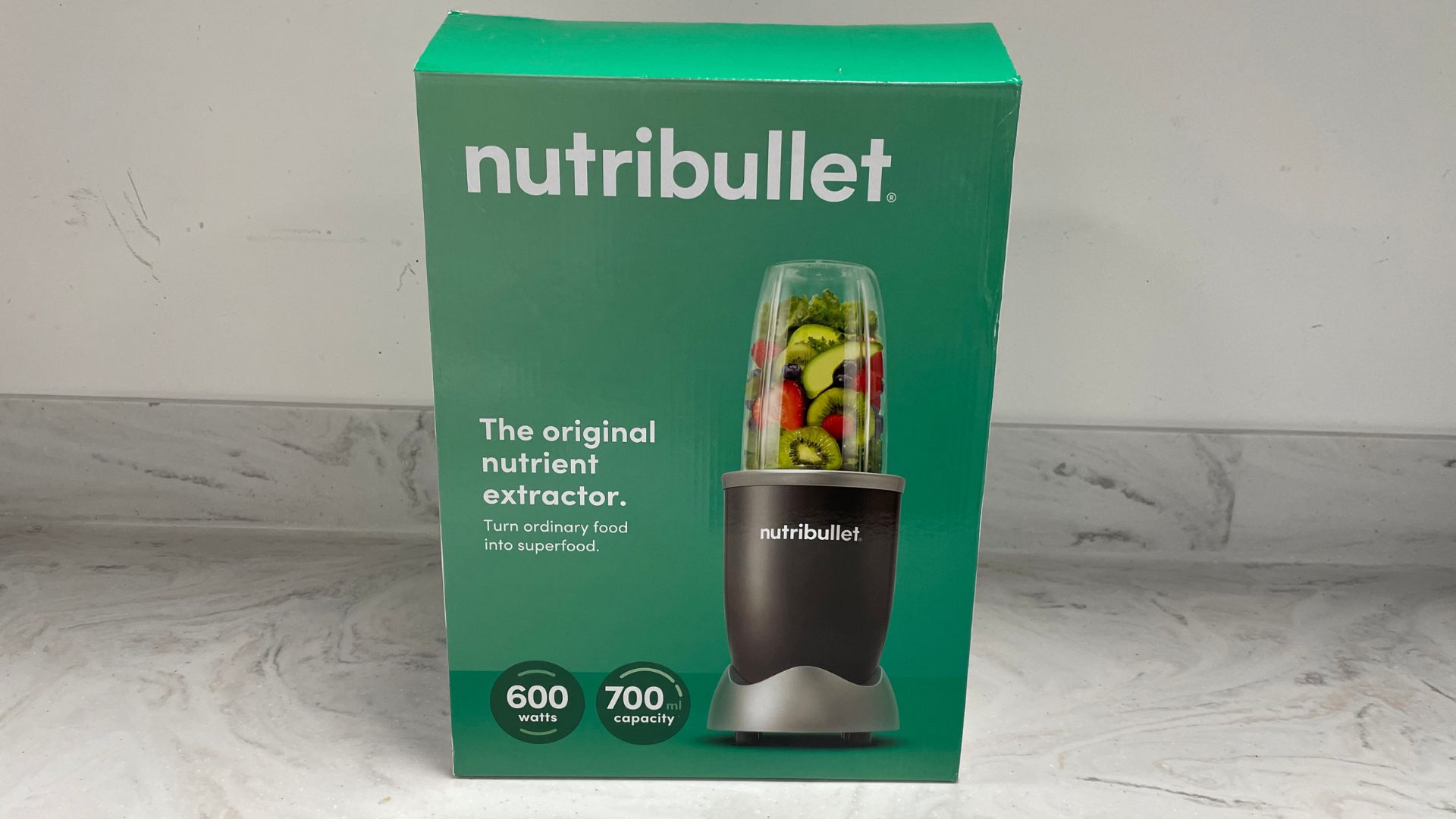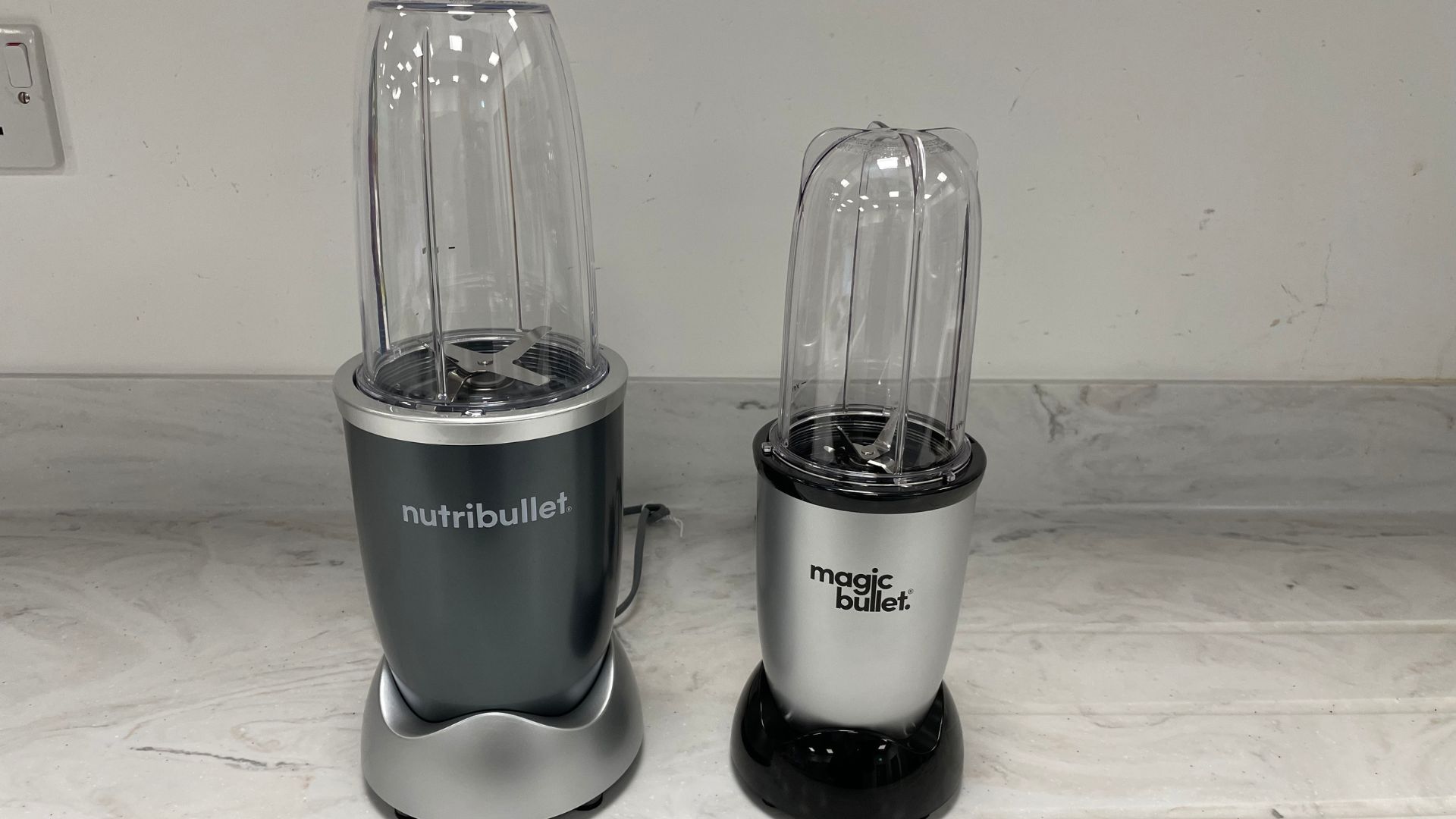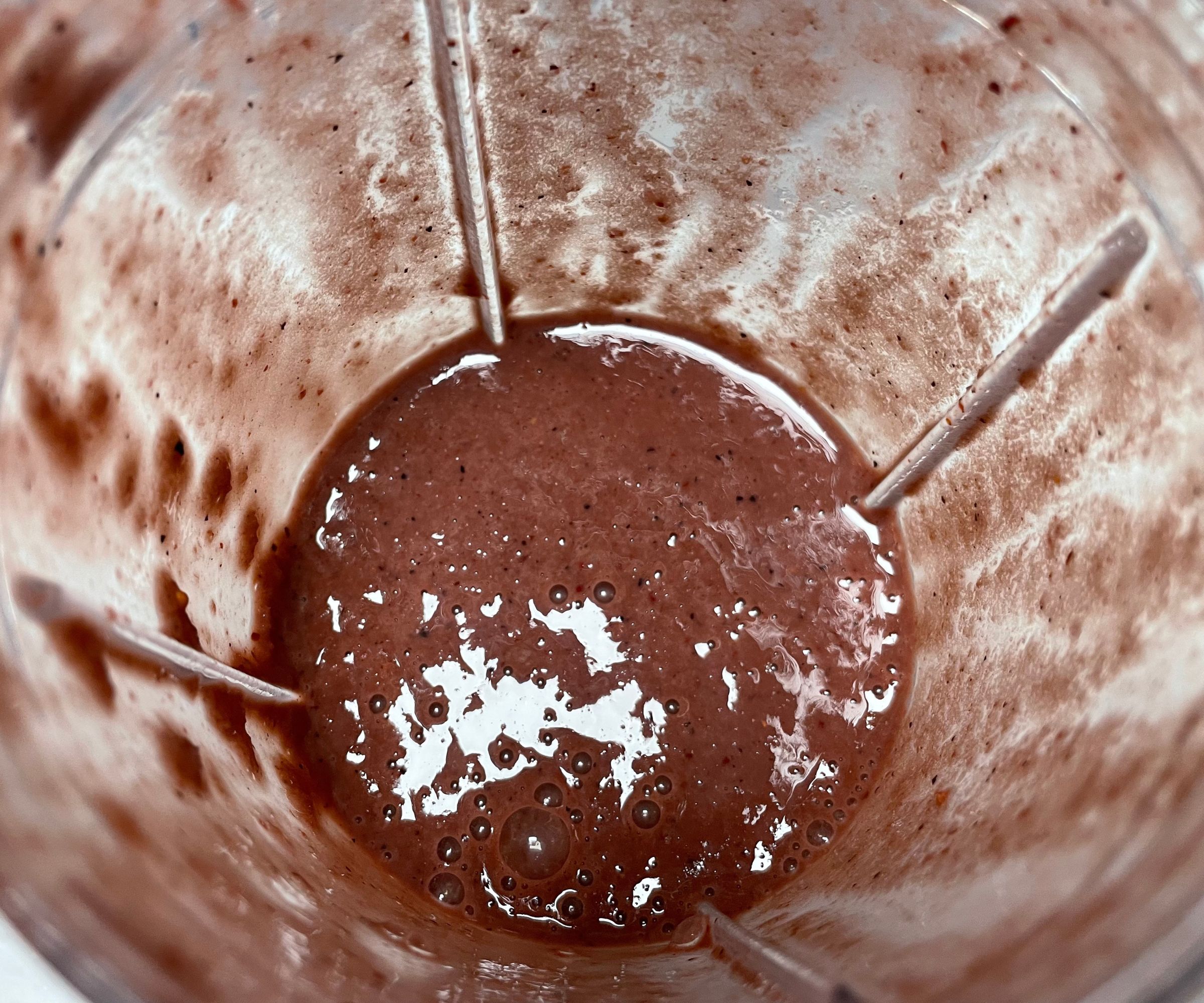
If you've thought about buying a bullet blender, chances are, it was a Nutribullet. the Nutribullet 900 Series isn't the latest model out there, but if you want value for money, this is the one to get.
As a lifelong lover and user of Nutribullet blenders, I'm familiar with what the brand has to offer. I've tested their Pro 900, Ultra, and portable blender, all of which boast credentials that you would expect from the best blenders on the market. However, when it comes down to taking the plunge and investing in just one, which do you choose?
I put the Nutribullet 600 Series through its paces, making smoothies, dips, and ice cones with the blending icon. It's a simple amd stylish model that I think would suit most homes. Here's everything you need to know to work out whether it's the perfect model for you.
Specifications

Unboxing

The NutriBullet arrives in a bright, cardboard box that you’ll be able to recycle straight away. Inside, NutriBullet sends the power base, a 680 ml cup, a 511 ml cup, a lid, a handle, and some instructions. These are all wrapped in thin plastic, which isn’t great from an environmental perspective, but if you go to a large supermarket, you’ll have a soft plastic recycling there.
The different-sized cups, handles, and lids might sound like a lot to store but they’re very well-designed. The two cups stack into each other, the handle slips around them, and the lid screws on. Having these extras can save you from needing to wash up your blender as well as your protein shaker, because they transform the blending bullet into your bottle — space-saving and smart.
Who would it suit?

You’ll find out more as we get further into the review, but the NutriBullet has two main appeals. First, it’s the smoothie expert. The bullet shape, cup-come-blending bottle, and blades are designed to make a really creamy, delicious drink. The less liquid you add (say with dips and ice cones) the less effective this is. The NutriBullet has its smoothie niche and it sticks to it. As a slim, single-speed blender, this is brilliant. It won’t cost you a fortune and it does a fantastic job too.
The other major strength that the NutriBullet boasts is its size. The bullet shape and slim base make this perfect for any small kitchens and urban spaces. It will sit in deep drawers just as well as it would a cupboard, or even the counter, which is something that’s really useful. Blenders seem to be getting bigger and bulkier, but NutriBullet stayed slim. Of course, this does mean that you will struggle to whizz up four or five smoothie portions for the whole family, but it makes it perfect for singles or couples.
What is it like to use?

These days, lots of people are familiar with how the NutriBullet works. You put the food into your blending cup, screw on the motor (tightly), and then flip it upside down. Sit it on the NutriBullet power base, push down, and twist to lock it into place. The NutriBullet will then whizz away until you unlock the bullet by pushing down twisting the opposite way. There are instructions that will talk you through this, but it’s all very intuitive.
Test 1: smoothies and protein shakes

I have sung the Nutribullet’s praises for smoothie making, because I’ve been using these for 17 years to make my morning smoothies. I’ve thrown a lot at these blades and, as long as you add enough milk, this will get you a good, smooth drink. Whilst it would be great to rely on my day to day usage, at woman&home, we have a process to follow. I always make a smoothie and a protein shake in a very specific way. I use frozen berries (these are hard to cut through because they’re icy and the seeds are also hard to whizz into insignificance). I also add some leafy greens and oats, because these have extra fibres and skins that bad blenders won’t cut through. I want these to be completely blended into my smoothie, so much so that I wouldn’t know if there’s anything was a handful of kale and a cup of oats alongside my blueberries and peanut butter. Of course, I’ll add almond milk and then I’ll set the blender running for my smoothie test.
The NutriBullet, as expected, did a great job. It’s as noisy as you might expect a blender to be (72dB according to my checker) but it had made me a good, silky smoothie in under a minute. In the bigger blending cup, I made enough for three glasses. The smaller one functions best as a personal blender. My word of warning is to never over-fill these or cut back on the liquid. These are the two ways in which your smoothie could fall down and end up lumpy, seedy, or skin-ny.
For all the gym bunnies out there, I add a scoop of protein powder and creatine. These can go lumpy in liquids, so it’s a very straightforward way to test the power and thoroughness of the blender. It’s also a good indicator of whether you could use the blender to make batters for pancakes or waffles, if you wanted to. I added my powders to the smoothie, screwed the lid back on, and let the NutriBullet get to work. I could see it quickly and effectively integrating my protein powder throughout the smoothie. As I promised, this delivers sensational smoothies.
Test 2: hummus

If you want your blender to work hard in the kitchen, you’ll also look for how it can handle dishes with lower liquid contents. The best way to test this is with dips, such as hummus. I make hummus with all the blenders that we test, so it’s easy to check. I add a tin of chickpeas, a squeeze of lemon juice, a tablespoon of tahini, a tablespoon of olive oil. a pinch of salt, and some cumin. The NutriBullet reached 80 dB trying to whizz the chickpeas up into hummus. Having less liquid was certainly a challenge. However with some extra lemon and olive oil and a few stirs and shakes, this made a good hummus. I like mine a little chunky and with some texture, so I was pleased with this. However, I am well aware that this is a slightly different dish to the yogurt like hummus that some people prefer. You won’t get that texture in the NutriBullet without adding a lot of liquid, by which time, you’re probably making a chickpea soup rather than anything else.
Test 3: crushed ice

Whether you want crushed ice for cocktails or ice cones, it’s handy to have a blender that can mist big ice cubes in seconds. Unfortunately, even with a splash of water, ice cones aren’t in the Nutribullet’s repertoire. The picture above shows you that it can do a little bit (with a lot of rattling and noise), but I wouldn’t count on it at dinner parties. It’s simply not in the Nutribullet’s design.
What else can/can't you make?
As you can imagine, over the years, I’ve tried making a few different things in the Nutribullet. If you wanted to make a power, say oat flour from oats, the Nutribullet is great for that. The oats are light enough to fly around the bullet and get broken down. You can also make soups, but you’ll need to cool the ingredients before adding them to the Nutribullet otherwise there will be a pressure build up and your bullet will crack. What you’ll struggle to make is peanut butter (the whizzing around will overheat the base) and anything thick. In short, you’ll probably need to invest in a food processor as well as the Nutribullet, if you want something handy around the kitchen.
Cleaning

Luckily, the Nutribullet is completely dishwasher safe. This means that you can put the blending cup and the blades in the dishwasher. I like to wash my blender by hand, because it’s a lot less wear and tear on both the cups and blades and this is easy. There are some lines running down the inside of the blending cup, so make sure to use a soft sponge as well as a washing up brush to really reach all parts. I normal pop some washing up liquid and cold water in the blender and run it like a smoothie to free up any loose left overs from under the blades as well as around the cup. All in all, it’s simple.
How does it compare?

If you’re looking at bullet blenders, you’ll have seen two other comparisons pop up time and time again. First, there’s the Nutribullet Pro 900. This is more expensive, essentially, because it’s more powerful. All the parts belonging to both the 600 and 900 are compatible, so you can switch between the two. I’ve moved over to the 900, because I use my blender to make lots of alternative flours (such as the oat flour that I mentioned earlier). However, if you’ll be making smoothies with soft fruits, you don’t need to spend more money on the Pro 900.
As for the Magic Bullet personal blender, this single-serve model is smaller and even cheaper than the Nutribullet. Whilst it will blend fruits into a drinkable smoothie, I wouldn’t choose it over the Nutribullet. When I tested the Magic Bullet, there were a few seeds and stray skins that I wouldn’t expect from a decent blender. It’s fine (and I love the Kitchen Express), which is a mini food processor and blender in one, but it’s not for the smoothie snobs.
There is a chance that you’ve realised that you need a blender that can do more than make smoothies. If you’re worried that this is you and you don’t know where to look, you’re in the perfect place. I have a whole guide to the best blenders on the market and plenty of those are jug blenders, which are more versatile and much more family-friendly. My go-to is the Ninja Foodi, because this can make hot soup, sauces, jams, jellies, butters, breadcrumbs, and just about everything else you could dream of, without having a toppy price tag. The only downside of this one is that it isn’t dishwasher safe.
Should you buy it?

If you’re a smoothie obsessive, looking to streamline your process whilst achieving the silkiest smoothies, this is the blender to buy. It’s flawless when it comes to drinks and shakes, but it will struggle to compete with jug blenders when you start tasking the blades with recipes that have lower liquid contents.
How we test

At woman&home, our testing process covers three tasks. These are designed to give the best possible idea of a blender’s capabilities, so that you know what you’re investing in.
The first task is making a smoothie. These drinks are almost synonymous with blenders, so it’s pretty important that a blender I recommend can do this well. I throw seedy fruits, leafy greens, and fibrous oats in the mix, as well as protein powder. This helps me get a good idea of the blade strength and motor power, because a good blender should make light work of this all.
The second test that I always go is on making dips, namely hummus. The liquid content here will be much lower than with smoothies, which can make it harder for blenders to achieve perfect results. The reason I like to do hummus is that chickpea skins can be really touch to break down, especially in a lower liquid context.
After that, I test how well a blender crushes ice, which is really tough. Very few blenders do a good job of this, but it’s always the powerful, impressive ones that do it well. This Is handy, not just for if you want to crush ice, but for if you know you’ll be blending ingredients that are harder or tougher than average.
Whilst I’m doing all the testing, I’m measuring noise, making notes on the cleaning, comparing the blender, and doing everything I can to deliver you a holistic idea of what it’s like to live with the blender. After the review, you shouldn’t have any more questions. If you do, please feel free to email me.
To find out more, you can visit our dedicated page for how we test blenders.







